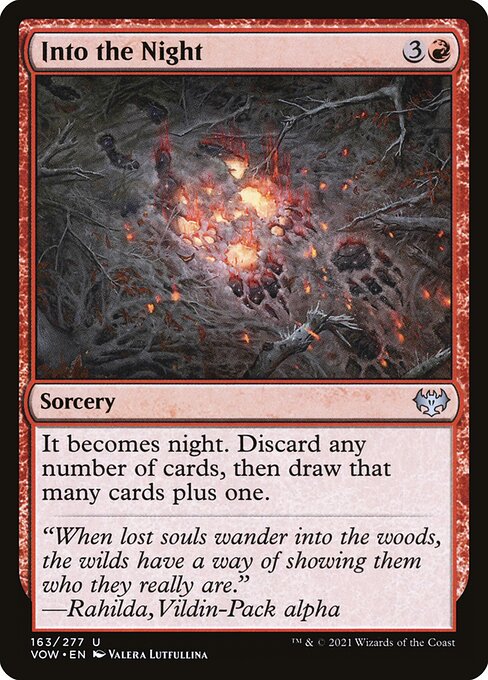
Image courtesy of Scryfall.com
Contextualizing Into the Night within Magic's Timeline
Magic's history is stitched together by cycles, eras, and subtle shifts in how a single phrase can tilt the game. Into the Night, a red sorcery from Innistrad: Crimson Vow, sits at an intriguing crossroads in that timeline. With a mana cost of 3R and a modest rarity of uncommon, it’s not a finisher in the classic sense—but it is a tempo-shifting, memory-building engine that leans into the plane’s long-running day/night motif. The card text—“It becomes night. Discard any number of cards, then draw that many cards plus one.”—invites players to trade hand size for late-game inevitability, a hallmark of Crimson Vow’s horror-hosted thrills 🔥. Its very presence resonates with the broader MTG timeline, where the nocturnal toggle and the flip-side narrative of Daybound/Nightbound have evolved from a thematic curiosity into a core gameplay rhythm 🧙♂️.
A quick primer on Day and Night in MTG’s arc
To place Into the Night on the timeline, you first meet the Day/Night concept that runs like a pulse through Innistrad’s storytelling. The original Innistrad block introduced a day-to-night mechanic, where the state of the sky could flip the battlefield—transforming Day creatures into Night opponents, and vice versa. That flip mechanic matured into the Daybound/Nightbound framework that reappeared in later Gothic horror sets, providing a recurring engine for werewolves, vampires, and the eerie wilds to assert themselves on the table. In Crimson Vow, Into the Night leans into that heritage by explicitly signaling a shift toward Night, nudging games toward a draw-sculpted finish that fits the set’s mood and cadence 🧭⚔️.
Gameplay implications: how this card ages in a game plan
At the obvious level, Into the Night asks you to discard in exchange for value—an old-school snowball, but with a modern twist. You set the pace by deciding how many cards you’re willing to shed to fuel your next draw spree. The math matters: if you discard N cards, you draw N+1 cards. That extra card is not just a number—it's a tilt toward late-game inevitability, especially in red shells that can pressure mana and tempo while still unlocking a big draw-turn. The red color identity ensures you can leverage Direct-damage and card-disruption tools to set up the discard, while the added Night mechanic can turn a treacherous tempo swing into a favorable board state as the night falls 🌃🎲.
“When lost souls wander into the woods, the wilds have a way of showing them who they really are.” — Rahilda, Vildin-Pack alpha
The flavor text anchors the card in Innistrad’s lore, where the woods aren’t just scenery but a character that reveals truths under the night sky. The art by Valera Lutfullina captures a moodier, more intimate horror aesthetic—an evocative blend of practice and poetry that fans of the plane instantly recognize. That connection to the night cycle isn’t just cosmetic; it’s a reminder that these cards are designed to be read as part of a living timeline—a history of how day folds into night and how a simple spell can nudge that fold a little sooner or a little harder 🖼️🎨.
Lore, art, and the craft of timeline-building
Crimson Vow continues Innistrad’s tradition of storytelling through flavor, montage, and character. Rahilda’s line reminds players that the world isn’t static; it breathes, hunts, and reveals. For timeline enthusiasts, Into the Night is a marker of how Wizards of the Coast uses a single line of text to nod to years of design history. The card’s legendary-inflected flavor notes also nod to a broader habit: the set positions itself as a bridge between classic gothic you-what-are-we-doing-werewolves and modern, high-velocity red strategies. It’s not a grand mythic moment, but it’s a telling pivot point—a microcosm of how MTG’s lineage can feel both ancient and freshly minted at the same time 🔥.
Where it sits in format and value chatter
From a format standpoint, Into the Night is legal in Historic, Modern, Pioneer, Legacy, and Commander. It’s not standard-legal, which is exactly where Crimson Vow’s nocturnal canvas tends to land in the broader ecosystem—valued more for its long-term play patterns than for a single, explosive move. The card’s market data places it as a modest collector piece in non-foil and foil variants, a comforting reminder that the best MTG history articles aren’t always about the rarest receipts, but about the stories those cards tell when they sit on the shelf beside a well-worn red deck 🧠💎.
Beyond the battlefield, Into the Night also helps illuminate the way the Innistrad story threads through the multiverse. It’s a practical engine card with flavor-forward storytelling. For players chasing a thematic red build, it’s a natural fit with discard-aware strategies and card-drawing engines that love a late surge, especially when the night’s mood can flip to your advantage 🥇⚔️.
Practical takeaways for timeline detectives and deck builders
- Use Into the Night to convert a hand-size deficit into card-advantage momentum, especially if you’ve got reliable ways to dump cards and redeem them with a single powerful draw (+1 extra). 🔥
- Appreciate how the text nods to Day/Night cycles—this is design storytelling as much as it is card power, a taste of the classic Innistrad era blended with Crimson Vow’s modern sensibilities 🧙♂️.
- Consider synergy with other red draw-discard engines and with cards that reward you for having fewer cards in hand, or that punish your opponent for not keeping pace with the night’s pace 🎲💎.
For fans who love curating timeline-aware decks, Into the Night is a compact, thematically rich piece that reflects how MTG blends lore with mechanics. Its very existence is a reminder that the multiverse’s history isn’t written in one dramatic chapter but in a constellation of small, luminous moments that creators and players alike keep returning to—when the night falls, we draw new stories from our sleeves ⚔️🧩.